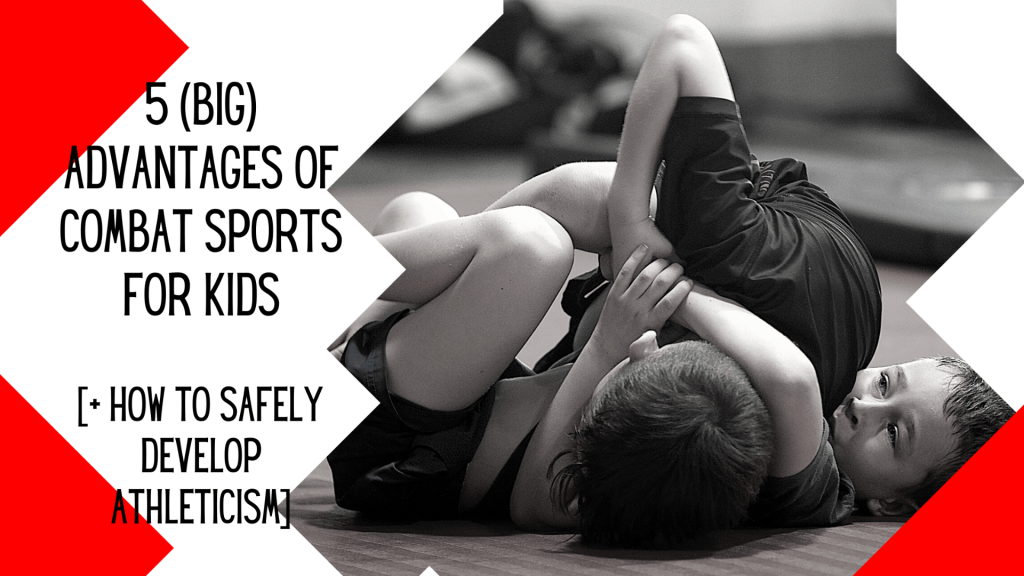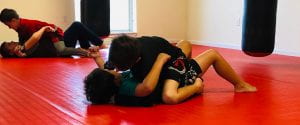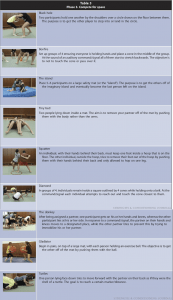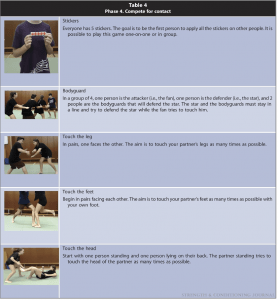
As adults, we are responsible for shaping the next generations of humans.
No problem, right?
We want them to grow up to have a happy and healthy life and thrive while being productive members of society. But that is a lot of responsibility. So, how do we make sure we’re doing the right thing?
One of the best ways (in my opinion) to set kids up for success is by introducing them to sports and other physical activities at a young age. Participation in organized sports programs, whether recreational or competitive, has numerous health, wellness, and performance benefits. However, there are definitely some sports and leisure activities that have a greater positive impact beyond the traditionally played swimming, basketball, football, soccer, etc.
Enter: combat sports. AKA martial arts.

What Are Combat Sports?
Combat sports is a blanket term:
Grappling-Based Martial Arts
- Judo
- Wrestling
- Brazilian jiu jitsu (BJJ)
- Jiu Jitsu
- Russian Sambo
Striking-Based Martial Arts
- Kickboxing (Muay Thai)
- Taekwondo
- Karate
- Boxing
- Krav Maga
- Kung Fu
Hybrid Styles
- Mixed Martial Arts (MMA)
Weapons-Based
- Kendo
- Kenjutsu
- Eskrima
Meditative, Low-Impact
- Tai Chi
Other Styles
- Wushu
- Hapkido
- Aikido
- Capoeira
While this is certainly not an exhaustive list, it does go to show the diversity within the ‘combat sports’ category, with numerous martial arts styles and disciplines to choose from.
5 (BIG) Advantages of Combat Sports for Kids

Kids are naturally active and curious creatures.
By participating in structured martial arts classes that are conducted in a supportive and fun environment, kids are given an outlet for their energy as well as the chance to learn basic skills vital to lifelong success.
Thus, martial arts can be an effective tool for helping kids develop physically, emotionally, mentally, and socially. And, when kids are having fun, they are more likely to retain what they’ve learned.
Consider these impressive benefits combat sports can offer kids:
1. Improves Fitness & Motor Skill Development
One of the most obvious rewards that different combat sports offer relates to physical activity. By its very nature, martial arts gets kids moving, which is especially important nowadays since recent trends in physical fitness show children are less physically capable than they were 10 years ago (Radnor et al., 2020).
Martial arts helps refine motor skills and improves fitness in ways that are appropriate for kids’ current developmental levels.
- Build physical strength and power
- Enhance hand-eye coordination
- Demonstrate deliberate movements and body control
- Improve balance and flexibility
Research also suggests that youth participants can experience increased cardiovascular fitness and anaerobic capacity (Fukuda et al., 2011). In fact, the same study demonstrated that the aerobic capacity, (which is the ability of our heart and lungs to provide oxygen to our muscles), in junior judo athletes was not only greater than non-athletes but also soccer players and even gymnasts!
2. Enhances Cognitive Development & Performance
The health benefits of martial arts extends beyond just the physical abilities and athletic qualities. Evidence also exists indicating improved cognitive performance in participants of combat sports. Morales et al. (2020) noted that regular martial arts training in children can boost executive functions.
Even more impressive, though are the studies that show how athletes with more than 10 years of judo experience possess higher gray matter volume in areas of the brain related to motor learning, planning, execution, memory, and cognitive processes (Fukuda et al., 2011).
3. Provides a Safe Space to Temper Negativity
Combat sports training also helps kids alleviate anxiety, aggression, and other negative emotions in a safe and constructive way. Many studies describe how youth participants of different martial arts disciplines undergo improvements in emotional well-being as well as experience greater satisfaction with their quality of life (Morales et al., 2020).
4. Teaches Important Core Values
It’s a pretty common misconception that martial arts teaches violence. In reality, instruction focuses on respect, discipline, self-control, humility, and patience– with fighting being a last resort in practical situations.
- Kids learn to respect themselves, their abilities, and others
- Learning new skills and progressing through the belt and/or ranking system helps increase confidence and self-esteem
5. Promotes Crucial Life Skills
According to Morales et al. (2020), the lessons learned in combat sports transfers to life outside the participation of the activity:
- Improved motivational climate in the classroom
- Reduced tendency to justify violence
- Improved social relationships
Martial arts classes also:
- Help kids learn social skills like cooperation, teamwork, and sharing
- Teaches youth the importance of perseverance, dealing with frustration, overcoming disappointments, and learning from mistakes
- Instruct kids about good sportsmanship, accepting defeat, and how what you do after a loss is more important than the loss itself
- Helps children and adolescents learn peaceful, non-violent conflict resolution skills that ultimately avoid physical altercations
If Combat Sports are SO Great, Then Why Don’t More Kids Participate?
Unfortunately, there’s a lot of misunderstandings and myths surrounding combat sports that affect kids’ participation levels.
Myth # 1: Martial Arts Teaches Violence
One of the biggest deterrents for enrolling youth in combat sports is the idea that martial arts is violent and encourages brutality.
While martial arts may have its roots in fighting, it is much more than just a form of combat. AAMA (n.d.) described martial arts as:
- A codified system based on cultural traditions
- Training that gives prominence to physical, mental, and spiritual development
- A tradition that teaches peace, discipline, and respect
Some communities have even used martial arts classes as an alternative rehabilitation treatment option to treat juvenile delinquency and violent adolescents. Using martial arts-based interventions has shown to provide youth with expanded skill sets:
- Critical thinking,
- Self-awareness,
- Self-control, and
- Overall enhanced physical and mental well-being (Joseph, 2015)
Myth # 2: Martial Arts is Too Dangerous
Another obstacle of youth combat sports participation revolves around the potential for injury.
Not going to lie- the risk of injury is a real thing. But, that goes for any sport, really.
It’s also important to bear in mind that most martial arts injuries, if they occur, are acute; very few catastrophic injuries have been reported in children who participate in combat sports (Demorest, 2016).
Keep reading to learn how to minimize the risk of injury for kids in combat sports!

Progressions for Safe, Martial Arts Development
Part of working with the younger generations is properly understanding how to develop fitness and appropriate levels of athleticism during the periods of growth and maturation that define childhood and adolescence (Radnor et al., 2020; Read et al., 2020). Kids are constantly going through stages of development, and a host of physical, psychological, social, and environmental factors all influence their ability to train.
Long-Term Athletic Development Model
The Long-Term Athletic Development (LTAD) model was created as a framework to help sports participants reach their full potential with planned, systematic, and progressive individual programming that increases the chance of lifelong physical activity participation (Ellerton, 2019).
According to Ellerton (2019), when participating in combat sports, coaches should follow an LTAD approach, which begins with building physical literacy (mastering basic human movements, fundamental movement skills, and foundational sport skills) in a fun environment, while also considering several other categories:
- Chronological Age: the number of years since birth
- Relative Age: the differences in ages among children born in the same calendar year
- Developmental Age: physical, mental, cognitive, and emotional maturity
- Skeletal Age: the maturity of the skeleton based on bone development
- General Training Age: the number of years of previous training exposure
- Sport-Specific Training Age: the number of years since the athlete specialized (when an athlete limits their participation to a single sport)
- Intellectual, Emotional, and Moral Development: the variation in the rates of development in kids affects their capacity to make decisions and deal with the emotions that coincide with sports experiences
Combat Sports Activity Progressions
Morales et al. (2020) recently published an excellent methodology for youth combat sports participation that embraces an LTAD perspective. The strategy takes into account the need for gradual steps to introduce children and adolescents to martial arts with game-based activities.
The progression slowly introduces the close, physical contact inherent to combat sports activities, emphasizes individual growth, and encourages respect through emotional (and physical) self-control and peer safety (Morales et al., 2020).
(Click on the images to enlarge the picture of activity examples for each phase)
Phase 1: Accept Contact
This is the introductory phase, as kids are often hesitant or shy about initiating contact with other kids. The goal here is for participants to get more comfortable with personal contact through hugging, holding, and carrying exercises.
Phase 2: Compete for an Object
This is where direct opposition is first presented. Kids continue working on getting more comfortable with confrontation by initiating an ‘attack’ on an object, like a ball or handkerchief, while the other defends. And then roles are switched.
Phase 3: Compete for Space
Here, the activities kids engage in start involving more strategic elements, with the objective to push an opponent out of a designated space, to keep your body in a specified space, or to reach a selected space. These types of exercises include pulling, pushing, and blocking techniques that are common to many martial arts styles.
Phase 4: Compete for Contact
At this phase, kids begin directly interacting with each other as aggressors and defenders. Participants practice maneuvers fundamental to various combat sports.
Phase 5: Compete for Body Position
The final phase most closely resembles practicing grappling combat sports, with hand-to-hand competition (simulated or real) that integrates gripping actions, pinning, and throwing techniques. As Morales et al. (2020) denoted, at this stage of training, kids have completed a natural progression of activities that have not only taught the movements of the chosen martial arts and the underlying principles that help keep one another safe but also several technical-tactical strategies for more advanced levels of instruction.
Final Thoughts
Martial arts is more than just a sport- it’s an opportunity for kids of all ages to learn important lessons that will help them succeed throughout all stages of life.
So, why combat sports for kids?
- Martial arts instruction focuses on the mind-body connection, which also helps instill important core values and life skills
- Participation helps kids learn respect, discipline, self-control, patience, and perseverance
- Martial arts improves many facets of physical and emotional health and well-being for a higher quality of life
- Introduction to combat sports, especially at a young age, builds core motor skills that can lead to sports achievement and proficiency
- Learning new skills builds confidence and self-esteem, which serve to establish positive relationships with physical activity and increases the chances of lifelong participation and healthy habits
And, despite the naturally combative nature of martial arts, children and adolescents can safely participate through the use of progressive activities as well as a long-term athletic development approach.

What are your thoughts about kids and combat sports? Share your comments below!
References
AAMA. (n.d.). The history of martial arts in America. AAMA Martial Arts Training Center. https://www.martialartsinbellevue.com/2018/02/24/the-history-of-martial-arts-in-america/
Demorest, R. A., & Koutures, C. (2016). Youth participation and injury risk in martial arts. Pediatrics, 138(6), 1-9. https://doi.org/10.1542/peds.2016-3022
Ellerton, H. (2019, April 12). What is the LTAD model and should you be using it? Human Kinetics. https://humankinetics.me/2019/04/12/ltad-model/
Fukuda, D. H., Stout, J. R., Burris, P. M., & Fukuda, R. S. (2011). Judo for children and adolescents: Benefits of combat sports. Strength and Conditioning Journal, 33(6), 60-63.
Joseph, J. (2015). Physical culture and alternative rehabilitation: Qualitative insights from a martial arts intervention program. In J. Joseph & W. Crichlow (Eds.), Alternative offender rehabilitation and social justice: Arts and physical engagement in criminal justice and community settings (pp.55-77). New York, NY: Palgrave Macmillan.
Morales, J., Fukuda, D. H., Curto, C., Iteya, M., Kubota, H., Pierantozzi, E., & La Monica, M. (2020). Progression of combat sport activities for youth athletes. Strength and Conditioning Journal, 42(3), 78-89.
Radnor, J. M., Moeskops, S., Morris, S. J., Mathews, T. A., Kumar, N. T. A., Pullen, B. J., Meyers, R. W., Pedley, J. S., Gould, Z. I., Oliver, J. L., & Lloyd, R. S. (2020). Developing athletic motor skill competencies in youth. Strength and Conditioning Journal, 42(6), 54-70.
Read, P. J., Oliver, J. L., & Lloyd, R. S. (2020). Seven pillars of prevention: Effective strategies for strength and conditioning coaches to reduce injury risk and improve performance in young athletes. Strength and Conditioning Journal, 42(6), 120-128.





When some onee sewarches for his vital thing, thus he/she needs to be available that in detail, so that hing is makntained over here.
my blog post … https://telegra.ph/Mobile-online-casinos-10-23
Jika ditemukan kerusakan pada saluran, kami juga menawarkan jasa perbaikan dan penggantian saluran. Tim jasa saluran mampet Semarang akan melakukan inspeksi menyeluruh untuk menentukan tingkat kerusakan dan memberikan solusi yang paling efektif. Semua perbaikan dan penggantian dilakukan dengan material berkualitas tinggi untuk memastikan daya tahan jangka Panjang